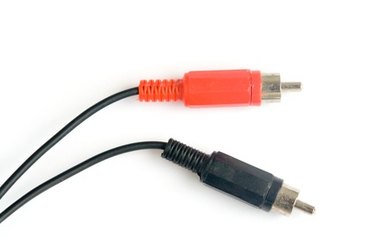
RCA cables and speaker wires are two of the most common cables in stereo systems. When setting up a home stereo, you're likely to encounter both types of connections, and it's important to know the uses and differences of the two.
RCA Cables
Video of the Day
RCA cables are shielded cables that are used to transmit line level signals. Line level signals are weak, non-amplified signals passed from audio components like CD and DVD players to the receiver. RCA cables have metal plugs on each end. There are typically two RCA cables per audio component—one for the left channel and one for the right. These cables are often color-coded as black and red.
Video of the Day
Speaker Wire
Speaker wire is a simpler wire with the singular purpose of connecting a receiver or amplifier to the speaker. Speaker wire carries an amplified signal as opposed to a line level signal. Each end of the speaker wire has two separate leads: a positive and a negative. Speaker wire is available in various gauges, with smaller gauge wire equating to thicker wire.
Uses in Stereo
RCA cables will be used to connect the audio output of each of your audio inputs (CD player, MP3 player, TV, etc.), assuming that you're not using a digital connection. An RCA cable is also used to connect a subwoofer or LFE (Low Frequency Effects) output to the subwoofer. Speaker wire, on the other hand, is used solely for hooking up the speakers. Speaker wire also can be used to connect to a passive subwoofer, which is not able to amplify the signal from a line level RCA input.